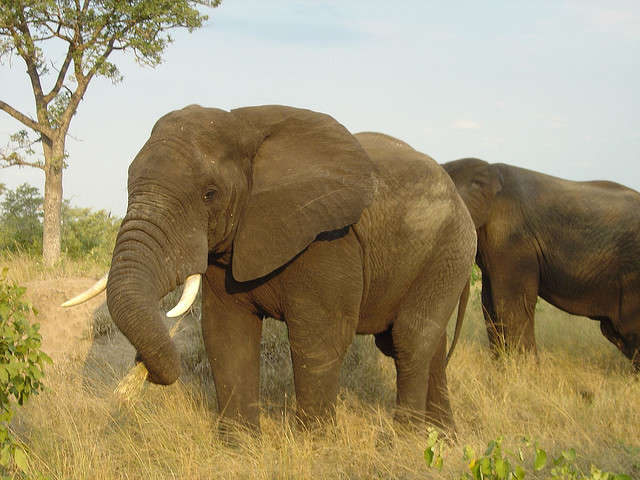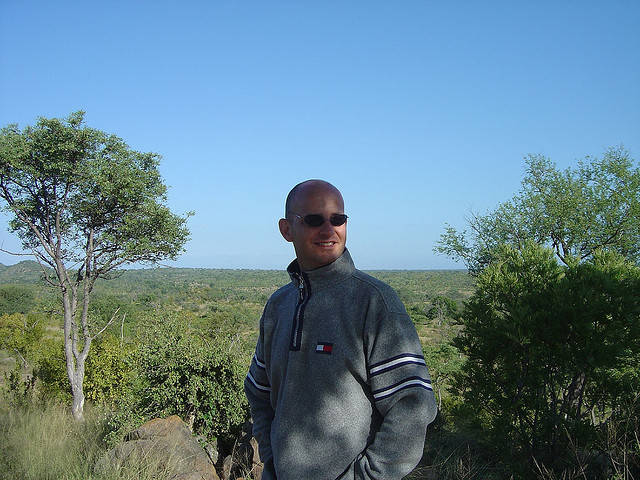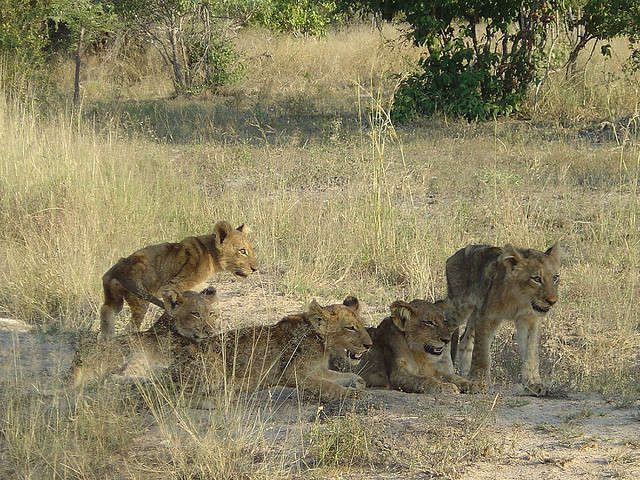Hunt the “Big Five” in Sabi Sands Private Game Reserve, Kruger Park, South Africa
Sabi Sands Game Reserve Private Game Reserve at Kruger Park South Africa
If you’re looking for something exciting and exhilarating to do on your next vacation, why not go hunting the big five game and shoot every single one of them? Just with your camera, of course.
There are few places that are quite like the magnificent Sabi Sands Private Game Reserve in South Africa. The Sabi Sands Game Reserve is located at, and attached to, the very famous Kruger National Park. The Kruger National Park is probably one of the best‑known national parks in the world, and is viewed by many as the best in Africa.
Kruger was originally established in 1898, so it’s well over a hundred years old. It was established to protect the wildlife of the South African Lowveld, and it has nearly two million hectares of land. It’s just enormous! It contains 336 types of trees, 49 fish (if you’re looking for fish in a nature park), 34 amphibians, 114 reptiles, 507 birds and 147 mammals. Of course, not in total numbers, but in different species and types.
The best time to go to the Kruger Park is in the winter months, which run in the southern hemisphere from April to September. The reason for that is the water is restricted to rivers and water holes, so visibility is incredibly good as the vegetation is not very thick. Whereas in summer it’s quite hot and humid during the rains, and the vegetation is lush and water more plentiful and so it’s harder to see the animals.
If you go to the area, and you want to splash out and treat yourself, then consider going to the Sabi Sands Private Game Reserve. It is located in the southwest of the Kruger National Park, and it is a very magnificent place to go and visit.
Although it’s a private reserve, it is connected to the public Kruger National Park, and the game are allowed to move between the two parks. So, Sabi Sands has all the benefits of the incredible amounts of game in Kruger, while having the most luxurious and special lodges. So it’s well worth a visit.
Sabi Sands can be reached by driving for about five to six hours from Johannesburg. But, most people will fly in there. It’s about a one‑hour twenty‑minutes flight from Johannesburg, and you can fly from providers based close to the main airport. Most of the lodges have private airstrips, or share a private airstrip, and so you fly pretty much to the lodge you are staying. You will be flying in small planes that can land on small private runways, most of which will be grass and soil.
Sabi Sands is home to many luxurious and very amazing lodges. There are 4 main types of lodges available which include:
1. Family Safari Lodges, which are (obviously) targeted at families!
2. Luxury Safari Lodges, which includes Elephant Plains Lodge, Idube Game Lodge, Lions Sands River Lodge, and Mala Mala.
3. Exclusive Safari Lodges, which are even better than “luxury”. These include places like Chitwa Chitwa Lodge, which is probably one of the best known other than Leopard Hills.
4. Premier Safari Lodge, which are even above “exclusive”. These include Londolozi, which has five different camps, and the Richard Branson Virgin Group Ulusaba Lodges .
One of the best sites to explore all the lodges at Sabi Sands is http://sabi.krugerpark.co.za
The strange thing about Sabi Sabi is that for decades it has been doing open top Land Rover type tours and so, over time, the animals have got used to these trucks. It can be quite surreal visiting Sabi Sands, as the animals seem tame – not vicious and wild!
Sabi Sabi itself was formed in about 1950 and tours have been taking place since then, and so the animals in this area have, through many generations, got used to the Land Rover trucks. And so they totally ignore them, and it’s very surreal because you’ll stop, for example, next to two leopard which are ripping to pieces some animal that they’ve killed. They will be about five or six feet away from you as you sit in an open truck. They completely and utterly ignore you.
One night, for example, our Land Rover was surrounded by a large pack of hyenas which were chasing a lioness and eating the carcass of a giraffe. We were parked right among them, the pack was a few feet away meandering around and cackling at themselves and at other animals, but just blanking us.
The game wardens warn you that the animals have grown up with these trucks and have come to know that they’re harmless, and so they see them as no threat, so they completely ignore them. But if you were to step out the truck or even to stand up then you would be recognised as alien and a risk, and they would likely attack.
When we were last in South Africa visiting the area a woman tourist, who had been driving through Kruger, had got out of her car to take some pictures of some lions, who then attacked and killed her. A similar thing had happened in Zimbabwe with some Japanese tourists who had been in a lion and cheetah park.
It is easy to forget how wild and dangerous the animals are. They calmly sit and walk close by ignoring you. But change the shape of the truck by standing up, and they instantly see a very different you
Another more upsetting side is that the rangers and the wardens will never intervene in a problem or issue that arises in the park with animals, if it is a natural event. When we were last there, there was a pride of three lionesses and 12 cubs. The lionesses had been struggling because they hadn’t been making a kill, and so had not been able to suckle and feed their cubs. So they started to abandon the cubs. These tiny little 10‑week‑old cubs were being abandoned and left them to die, most likely by being attacked by a predator.
It was quite distressing and upsetting seeing these little cubs sitting on the side of the roads, and hearing the wardens say that they would, could and should not intervene. Their view being that this is the wild, these animals need to be left to their own devices – and you don’t want to upset the equilibrium.
On the other hand we also saw an elephant who had been suffering because it had been snared. It was in a lot of pain and danger and, since the animal would eventually die of its injuries, so as to not prolong the suffering they did shoot it. This had happened not long before we got there. What was interesting is that the other elephants in the park were much more hostile and aggressive towards the trucks than apparently they would normally be. Elephants have incredibly good memories and they had realised that everything was not quite right.
Let me tell you a little bit more about Sabi Sands:
1. There are over 30 lodges in Sabi Sands, the most popular and rated are Longalozi, Sabi Sabi, Mara Mara, and Ulusaba.
2. You can see all the “big five” game in the park. It is particularly good for doing this because it’s a rather concentrated area.
⁃ The “big five” game term was originally termed by big game hunters. It’s the five large mammals that are indigenous to Africa. They chose these five animals because they were difficult to hunt because of their size.
⁃ The five are lion, elephant, buffalo, leopard, and the black rhinoceros.
⁃ It doesn’t include things like the hippopotamus because the hippopotamus isn’t hard to hunt because it lies around in pools and rivers all day.
⁃ The buffalo is actually considered to be the most dangerous of the big five game for hunters. They are very mean and very aggressive.
Here are my tips for travellers, if you’re visiting the Sabi Sands.
- When to go: Be very careful about the time that you go. I mentioned earlier that the best time to go is in the winter in the Southern Hemisphere, which is in the period from April to September. The reason for that is the vegetation is not very lush, and water is very short, so animals have to hunt out and find water.
- Chose your lodge type carefully: As I mentioned in Sabi Sabi, there’s a huge range of different types of lodges, from family, to luxury, to exclusive, into premier lodges. The days of kind of roughing it in little, sort huts with thatched roofs is pretty much gone. These are very luxurious places, so many of them will have luxurious features like plunge pools even attached to you room.
- We stayed at Ulusaba, which is owned by Richard Branson Virgin Group. It has two lodges. Rock Lodge which is on the top of a hill, and that’s the one we stayed at. It is right on the top of a hill built on stilts with thatched roofs, and you have incredible views over the bush and wildlife. They also have the Safari Lodge at the bottom of the hill. The rooms are built tree house‑style. The reason they do that is because the old riverbed it is built on is still a walkway for animals, particularly elephants walking by to get to a nearby watering hole.
- A typical day:
- It’s a very early start. You get up around five o’clock in the morning, have a coffee at five fifteen, and at five thirty you set out on a game drive. Usually stopping for some refreshments during a game drive for about three hours. It sounds a long time, but it goes incredibly quickly, and you can’t believe how fast nine o’clock comes.
- You have breakfast, and then you have most of the day to yourself to either go to the gym, have beauty treatments at the spa, or you can go on a walking safari.
- About four o’clock or so, you have afternoon tea and then you head off on a evening game drive until about seven thirty.
- Often what these lodges will do is while you are out in the bush they’ll then surprise you with some drinks, bonfires, some entertainment, and snacks.
- You will then return to the lodge for dinner, and you often go to bed quite late, eleven o’clock, twelve o’clock, and you are woken up again at four thirty. It’s quite an action packed day, and I have to admit that we had to skip the morning drive and just join the evening drive, but that’s kind of up to you, and pace yourself.
- I would strongly recommend that you fly up to Sabi Sands rather than drive. It’s a very long drive and you lose a whole day when you could be in the park. The flights are relatively inexpensive.Sometimes depending on which lodge you’re going to you may have to fly on one plane, for and change to a smaller plane that can land on the smaller grass strips at some of the lodges.
- Stay enough nights. It is relatively expensive staying at these places, but do stay enough nights. Some people only stay two nights, and it ends up being too packed and you just don’t get a chance to relax and enjoy the bush and unwind.
- We actually stayed for four nights, and that wasn’t even enough, because by the time you’ve had your drives and relaxed and perhaps had a swim, and generally enjoyed yourself and paced yourself, it’s gone.
- Be very careful and responsible. I’ve already mentioned the risks in the bush, but listen to the guides. They are there to protect you. They are incredibly knowledgeable, have huge passion, and many of them have been growing up in the bush all their life. Listen to them, ask them lots of questions because if they know that you’re interested they just open up and tell you the most amazing stories.
- Enjoy the facilities, and ask to visit the local community. I already mentioned these places have lots of facilities and incredibly interesting people working there. In addition to having spas, and pools, many of them can organise walking tours, but most will also do a community tour which will take place outside the reserve into the local village. This helps pump money into local schools and local communities.
I really strongly recommend visiting if you have never been on a safari. Visiting Sabi Sands game reserve was without a shadow of a doubt, one of the most magical and amazing holidays that I’ve ever had. There is something amazing about being out in the bush, driving around, looking at these incredibly stunning animals -and being able to get so close to them.




The ONLY way to “hunt” an animal and “shoot” it is with a camera! Trophy hunting is vile and sick! Trophy killing is no longer sustainable and it is certainly not ethical, nor is it conservation. Hunters LIE.